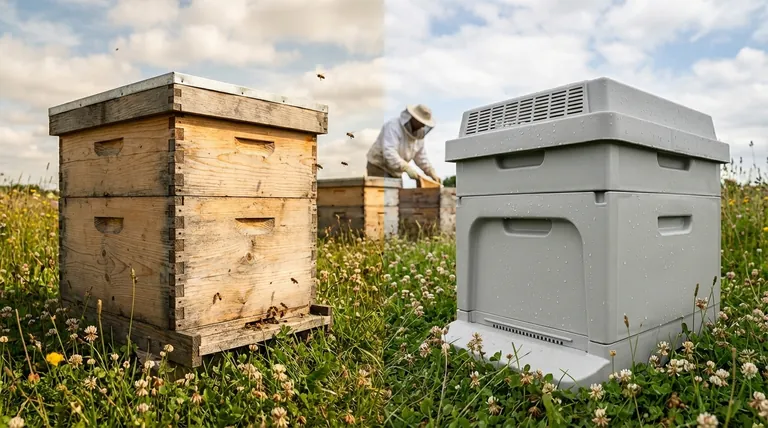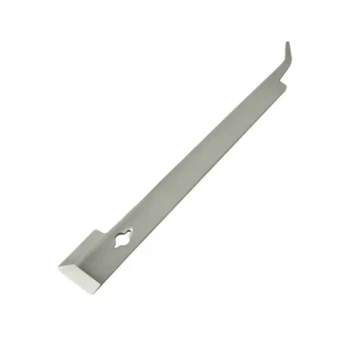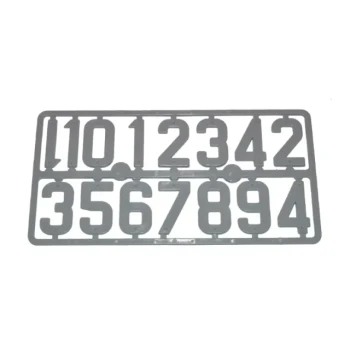The definitive answer is that the "better" material depends entirely on your goals as a beekeeper. Wood offers a more natural environment that bees readily accept and provides superior insulation. Plastic, on the other hand, offers unparalleled durability, a longer lifespan, and significantly less maintenance.
The choice between wood and plastic is not about which is universally superior for the bees, but rather a fundamental trade-off for the beekeeper: choosing between the natural, breathable environment of wood and the low-maintenance durability of plastic.

Durability and Longevity: The Core Advantage of Plastic
The primary reason beekeepers choose plastic is its resilience against the elements and the rigors of apiary life. It is engineered for a long service life with minimal upkeep.
Weather and Rot Resistance
Plastic hive components are completely impervious to moisture and rot. Unlike wood, they will not break down, soften, or decay when exposed to rain, snow, and high humidity over many seasons.
Structural Integrity
Wooden hive components, particularly frames, can warp or break over time under the heavy weight of honey and brood. Plastic is more rigid and maintains its precise shape, ensuring components fit together properly year after year.
Pest Resistance
Pests like wax moths can burrow into the grain of wooden frames to lay their eggs. Plastic's non-porous surface offers fewer hiding places for pests, making it a more sanitary and defensible environment.
Bee Health and Environment: The Case for Wood
Many beekeepers prefer wood because it more closely mimics the natural cavities, such as hollow trees, that honey bees have evolved to inhabit for millions of years.
Natural Material and Bee Acceptance
Bees have a natural affinity for wood and beeswax. They typically take to wooden components and natural beeswax foundation more readily than to plastic, which can sometimes require an extra coating of wax to encourage the bees to build comb on it.
Superior Insulation
Wood is a natural insulator. A standard wooden hive body offers significantly better protection from extreme summer heat and winter cold than a thin-walled plastic hive, reducing stress on the colony.
Moisture Management
Wood is porous and can "breathe," allowing it to absorb and release moisture. This helps regulate the hive's internal humidity and reduces the risk of condensation, which can be harmful to bees, especially during winter.
Understanding the Trade-offs
Neither material is perfect. Your decision requires weighing the convenience of one against the natural benefits of the other.
The Maintenance Burden of Wood
Wood requires active maintenance. It must be painted or sealed to protect it from the weather, and even with good care, components will eventually rot and need to be repaired or replaced.
The Acceptance Issue with Plastic
While durable, plastic is an artificial material. Bees can be slower to draw out comb on new plastic frames and foundation. Many beekeepers find they must add a thick, fresh coat of beeswax to encourage the colony to accept them.
Condensation Risk in Plastic Hives
Because plastic is non-porous, it can trap condensation. Without adequate ventilation, this moisture can drip down onto the cluster of bees, causing chilling and stress, particularly in colder climates.
Making the Right Choice for Your Apiary
To decide, first define your primary goal as a beekeeper.
- If your primary focus is low maintenance and long-term durability: Choose plastic hive components for a setup that will last for years with minimal intervention.
- If your primary focus is creating the most natural environment for your bees: Choose traditional wooden hives to leverage their superior insulation and moisture-regulating properties.
- If your primary focus is a balanced, hybrid approach: Consider using durable wooden hive bodies for their insulation combined with plastic frames and foundation for their longevity and ease of cleaning.
Ultimately, the best hive material is the one that aligns with your philosophy and keeps you actively and successfully managing your colonies.
Summary Table:
| Feature | Plastic Hives | Wooden Hives |
|---|---|---|
| Durability & Longevity | Excellent, rot-proof | Requires maintenance, can rot |
| Insulation | Poorer, thin walls | Superior, natural insulator |
| Bee Acceptance | Can be slower, may need wax coating | High, natural affinity |
| Maintenance | Very low | High (painting, sealing required) |
| Moisture Management | Risk of condensation | Natural 'breathing', regulates humidity |
| Pest Resistance | High, non-porous surface | Lower, pests can burrow into wood |
Equip Your Apiary with the Right Hive Material
Whether you manage a large commercial apiary or supply beekeeping equipment, choosing the right hive components is critical for productivity and bee health. HONESTBEE supplies durable, high-quality beekeeping supplies and equipment through wholesale-focused operations.
We help you make the best choice for your specific needs:
- Durable Plastic Components: For long-lasting, low-maintenance operations.
- Traditional Wooden Hives: For beekeepers prioritizing a natural environment.
- Expert Guidance: To help you select the perfect materials for your goals.
Ready to optimize your hive setup? Contact HONESTBEE today for wholesale pricing and expert advice tailored to commercial beekeepers and distributors.
Visual Guide

Related Products
- Langstroth Bee Hives Bee Keeping Box for Beginners Beekeeping
- Wholesales Dadant Size Wooden Bee Hives for Beekeeping
- HONESTBEE Advanced Ergonomic Stainless Steel Hive Tool for Beekeeping
- Professional Dual-End Stainless Steel Hive Tool for Beekeeping
- HONESTBEE Professional Long Handled Hive Tool with Precision Cutting Blade
People Also Ask
- How does the orientation of the hive sides benefit comb construction? Ensure Straight, Movable Combs for Easier Hive Management
- Why are Langstroth hives recommended for beginners? Unmatched Support & Standardization
- What is the best type of bee hive for beginners? Start with the Proven Langstroth Standard
- What basic equipment is needed to start beekeeping? Your Essential Guide to a Confident Start
- What are the different types of beehive boxes available? Choose the Right Hive for Your Apiary



















